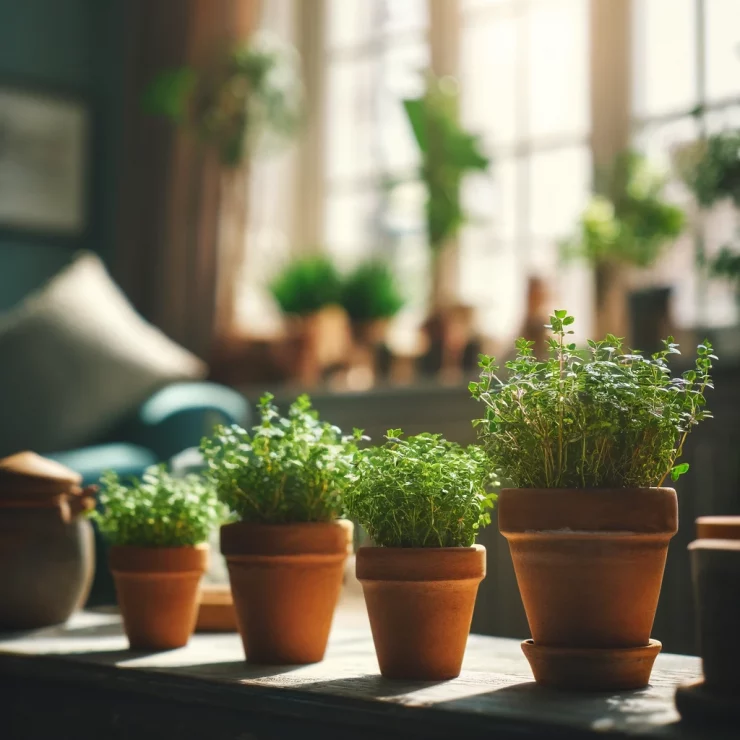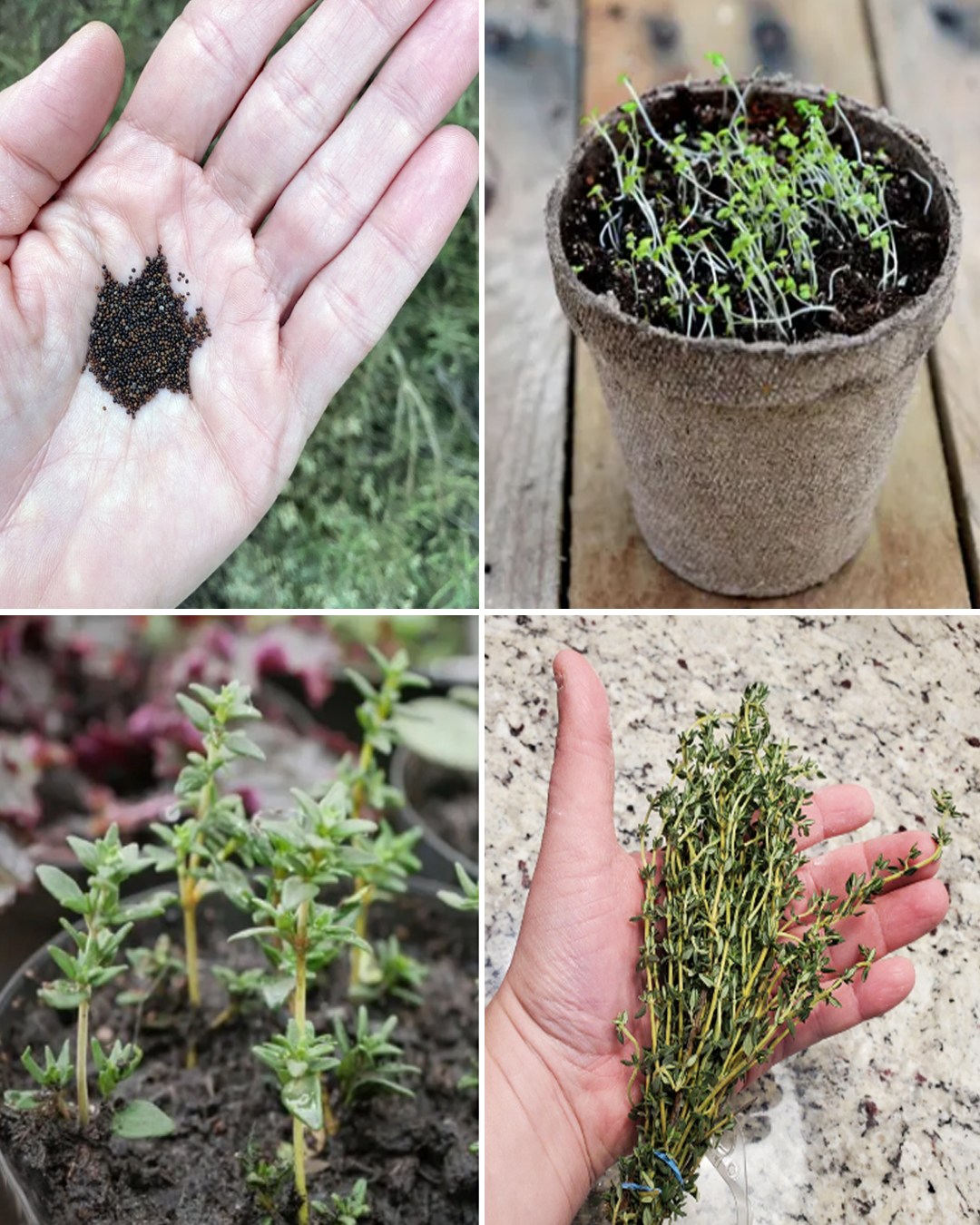Thyme, with its delicate leaves and robust aroma, is a versatile herb that adds depth and flavor to a wide array of dishes. While commonly found in outdoor gardens, thyme can also thrive indoors, making it accessible to urban dwellers and those with limited outdoor space. In this article, we’ll explore the step-by-step process of growing thyme indoors in containers, allowing you to enjoy this culinary staple right from the comfort of your home.

Choosing the Right Container:
When it comes to growing thyme indoors, selecting the right container is essential. Opt for a container that provides good drainage to prevent waterlogging, such as clay pots or plastic containers with drainage holes at the bottom. Ensure that the chosen container is at least 6 inches deep to accommodate thyme’s root system and allows for proper air circulation around the plant.
Selecting Thyme Seeds or Seedlings:
You have the option to start your thyme journey from seeds or seedlings, depending on your preference and availability. Thyme seeds can be sown directly into the container, while seedlings offer a head start in the growing process. If starting from seeds, sow them thinly on the soil surface and cover lightly with a thin layer of soil.
Ideal Growing Conditions:
Thyme thrives in well-draining, sandy soil with a pH level between 6.0 and 8.0. Place your container in a location that receives at least six hours of sunlight per day, such as a south-facing window or under grow lights. Ensure that the room temperature remains between 60°F and 70°F (15°C to 21°C) for optimal growth.
Watering and Maintenance:
Water thyme plants when the top inch of soil feels dry to the touch, being careful not to overwater, as thyme is susceptible to root rot in soggy conditions. Fertilize your thyme plant with a balanced, water-soluble fertilizer every 4-6 weeks during the growing season to promote healthy growth. Trim the plant regularly to encourage bushier growth and prevent it from becoming leggy.
Harvesting Thyme:
Once your thyme plant has reached a height of 6-8 inches, you can begin harvesting the leaves for culinary use. Snip off the top few inches of the stems, making sure not to remove more than one-third of the plant at a time. Thyme leaves are most flavorful when harvested in the morning before the sun has had a chance to evaporate the essential oils.
Using Fresh Thyme in Recipes:
Fresh thyme adds a burst of flavor to a variety of dishes, including soups, stews, sauces, and roasted meats. Simply strip the leaves from the stems and chop them finely before adding them to your favorite recipes. Thyme can also be dried for long-term storage by hanging bundles of stems upside down in a well-ventilated area until fully dry.

Growing thyme indoors in containers is a rewarding experience that allows you to enjoy fresh herbs year-round. With the right container, growing conditions, and maintenance, you can cultivate a thriving thyme plant right in your own home. Whether used to elevate your culinary creations or simply enjoyed for its aromatic fragrance, homegrown thyme is sure to enhance your indoor gardening endeavors.
News
JJ Redick reacts to Luka Doncic trade for Anthony Davis
In one of the most jaw-dropping moves of the season, the NBA landscape was rocked by the blockbuster trade involving Luka Dončić and Anthony Davis—a swap that has sent ripples of excitement, disbelief, and heated discussion through the league. Among…
Anthony Davis FULL reaction to trade to Mavericks for Luka Doncic
In a blockbuster move that sent shockwaves through the NBA and left fans reeling, Anthony Davis has been traded to the Dallas Mavericks in exchange for Luka Dončić. In the immediate aftermath of the news, Davis took to the media…
Shaq reacts to Dallas Mavericks wanting Kevin Durant after Luka-AD trade 👀
In the constantly shifting world of the NBA, trade rumors and blockbuster moves are a regular part of the season’s drama. The latest twist has fans buzzing: the Dallas Mavericks have reportedly set their sights on acquiring Kevin Durant in…
Donovan Mitchell FILTHY poster dunk on Kristaps Porzingis 😳
In a game filled with high-intensity moments and jaw-dropping highlights, one play in particular has left fans and analysts buzzing about Donovan Mitchell’s latest display of athleticism. Early in the contest, with the atmosphere already charged by an evenly matched…
Joel Embiid hits go-ahead bucket vs Mavs then chats with Anthony Davis after game
In one of the most thrilling contests of the season, Joel Embiid delivered a clutch performance against the Dallas Mavericks, punctuating the game with a go-ahead bucket that sent the home crowd into a frenzy. The atmosphere in the arena…
D’Angelo Russell game winner as Nets hit two 3’s in 3 seconds to win vs Rockets 😱
In one of the most electrifying moments in recent NBA history, D’Angelo Russell delivered an unforgettable game-winner that left fans and commentators in complete awe. With the Brooklyn Nets locked in a tense battle against the Houston Rockets, the outcome…
End of content
No more pages to load











